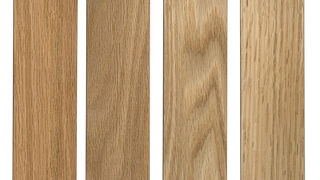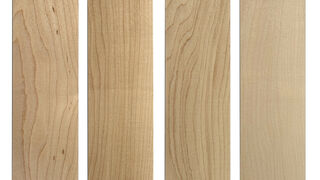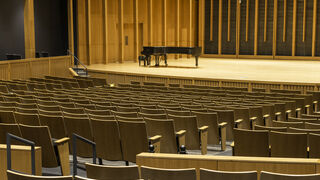Design and Craftsmanship
Considerations When Using Wood on a Project

Wood components offer several benefits over laminate, upholstered, or plastic alternatives. The natural grains and color variations in wood create warmth and authenticity, offering a unique touch that other materials can't match. Whether you're designing furniture or architectural elements, wood’s versatility shines through—able to be stained in an extensive range of colors, shades, and gloss levels to meet any aesthetic. Both solid wood and plywood components, when properly maintained, can last for generations. Plus, wood is easy to repair—scratches can be sanded and stained, and even deep gouges can be filled and restored.
Using wood also benefits the environment. Responsibly sourced from managed forests, wood helps lower carbon levels in the atmosphere. The cyclical process of growing and harvesting trees promotes forest health and regeneration. Additionally, the production of wood components requires less energy-intensive processes than synthetic materials, reducing fossil fuel consumption.
Where Wood Shines in Public Spaces
Wood components are most often used in performing arts centers, theaters, and auditoriums—spaces where designers aim to create a grand, formal atmosphere. The elegance of wood fits naturally in these environments, offering both aesthetic appeal and acoustic benefits.
However, wood may not be the right choice for every project. In high-traffic facilities like arenas and movie theaters, or spaces prone to vandalism, wood might not withstand the wear and tear as effectively as more durable, impact-resistant materials.
Understanding Natural Variations in Wood
One of the most appealing qualities of hardwood is its natural variation in color and grain. These variations depend on the species of the tree, growing conditions, and even the specific part of the tree from which the wood is sourced. For instance, heartwood—the inner part of the tree—often has deeper, richer tones, while sapwood appears lighter and more delicate. Environmental factors, such as soil composition and exposure to sunlight, further influence the wood’s natural hues.
Over time, wood develops a patina through exposure to light and air, enhancing its natural beauty. This variation adds character, making each wood component truly one-of-a-kind.
However, these differences can present challenges in projects where visual consistency is critical. For designers seeking uniformity, wood grain plastic laminates may offer a better solution. For those aiming to highlight wood’s natural beauty, manufacturers can use techniques like book-matching, which aligns veneer slices for a dramatic, deliberate pattern or slip-matching which helps to create a consistent, uniform pattern. Most veneers used by Irwin are slip-matched.
Examples of Wood Species and Their Characteristics
Different wood species offer distinct qualities in color and grain. For example:

Red Oak: Known for its grain fluctuations, Red Oak can range in color from deep red hues to yellow, with occasional hints of green. Its grain can be tight or loose, adding to its unique appearance.

Maple: North American Maple, by contrast, has a more consistent grain with color variations ranging from blonde to subtle red undertones. Its uniformity often makes it a favorite for furniture and architectural elements.

Most manufacturers, like Irwin Seating, standardize on certain species—such as Maple and Red Oak—but offer the flexibility to use others like Walnut, Birch, White Oak, or Cherry. This ensures the seating blends harmoniously with other architectural elements within the space. Similarly, while Irwin Seating offers eight standard stains, custom stains are frequently used to match other design elements.
This image of Hope College's Miller Center for Musical Arts shows White Oak chair components with a custom stain to match the other details within the theatre.
Finishing Touches: The Art of Staining and Top Coats

Once the wood species is selected, the final step is finishing. This process involves applying a stain followed by at least one clear top-coat layer. The number of top coats determines the gloss level—the more coats, the shinier the finish. Between each layer, the wood is scuff-sanded to ensure a smooth surface.
Today, water-based stains and top coats are preferred over traditional oil-based products. They emit fewer volatile organic compounds (VOCs), making them safer for workers and the environment. They are non-flammable, easy to clean up, and reduce grain raising, resulting in a smooth finish that preserves the wood’s natural beauty. Water-based stains also offer superior color retention over time and are less likely to yellow compared to traditional finishes.
It’s worth noting that finishing preferences vary by region. In North America and Europe, stains are often used to enhance the natural wood grain. Meanwhile, in some Asian countries, opaque stains or lacquer are used to conceal the grain for a more uniform appearance.
Conclusion
Wood offers a timeless and versatile option for furniture and public seating projects, adding both visual appeal and durability when properly maintained. Its natural variations make each piece unique, and modern finishing techniques ensure it stands the test of time. However, it's important to weigh the benefits and challenges, particularly in high-traffic environments.
If you're considering wood for your next project and want to learn more about how our wood products can enhance your space, contact our team today!
By:
Ross Slager, Focus Factory Manager—Wood Plant
Ross has spent 45 years working in the wood furniture industry, with 27 years at Irwin Seating. Outside of work, he enjoys crafting furniture and cabinetry.
Glossary
Oak (Red and White Oak)
- Red Oak: Known for its prominent grain pattern and pinkish hue, red oak is durable and widely used in furniture, flooring, and cabinetry. It's a favorite for traditional and rustic styles.
- White Oak: Slightly more water-resistant than red oak, white oak has a finer grain and a more neutral, yellowish-brown color. It's popular for both indoor and outdoor furniture.
Maple (Hard and Soft Maple)
- Hard Maple: Often called "sugar maple," hard maple is light in color, with a fine, consistent grain. It’s very strong and often used for furniture that needs to withstand heavy use, such as kitchen cabinets and flooring.
- Soft Maple: Slightly less dense than hard maple, soft maple is easier to work with and often used for painted furniture or pieces where intricate detail is required.
Cherry
- Cherry wood is prized for its rich, warm color that deepens with age. It has a fine, straight grain and is often used for high-end furniture, cabinetry, and decorative woodwork.
Walnut
- Walnut is a dark, dense wood with a straight, fine grain, though it can sometimes be wavy. It's one of the most valued North American hardwoods for its rich brown color and is often used for luxury furniture, cabinetry, and veneers.
Birch
- Birch is a light-colored wood with a fine, even grain. It's moderately hard and strong, making it suitable for furniture, cabinetry, and plywood. It's often used as an affordable alternative to maple or cherry.
Ash
- Known for its strength and elasticity, ash has a pale color with a straight grain. It's often used in furniture, especially where flexibility and durability are important, such as in bentwood furniture or sports equipment.
Hickory
- One of the hardest and strongest North American woods, hickory has a varied color range from white to reddish-brown with a coarse, prominent grain. It's used in furniture that requires high durability, such as chairs and rockers.
Poplar
- Poplar is a soft hardwood with a fine, even texture and is typically light cream to yellowish-brown in color. It’s easy to work with and often used for painted furniture, drawer sides, and interior parts of cabinets.
Plain-Sliced (Flat-Sawn):
- Description: Plain-sliced wood, also known as flat-sawn, is the most common and widely used method for cutting wood veneers. The log is sliced along its length, parallel to a line through its center, producing a series of straight, parallel cuts.
- Appearance: This method highlights the wood’s natural grain, resulting in a distinctive "cathedral" or "flame" pattern. The grain is varied and showcases the natural character of the wood, with broader and more random patterns.
- Common Uses: Plain-sliced veneers are often used in cabinetry, furniture, and paneling, where the natural beauty of the wood grain is desired.
Rift-Cut:
- Description: Rift-cut wood is produced by cutting at a 15° to 30° angle to the radius of the log, minimizing the prominent "cathedral" patterns seen in plain-sliced wood.
- Appearance: The result is a more uniform and linear grain pattern, with fewer variations and a more consistent texture. This cut is particularly prized for its clean and understated look.
- Common Uses: Rift-cut veneers are commonly used in high-end furniture, architectural millwork, and applications where a uniform appearance is desired.
Rotary-Cut:
- Description: Rotary-cut wood is made by peeling the log like a roll of paper, where the log is turned against a blade, cutting a continuous sheet of veneer around its circumference.
- Appearance: This method produces the broadest and most varied grain patterns, often with dramatic and pronounced grain variations. The grain is less predictable and can include large swaths of the natural figure of the wood.
- Common Uses: Rotary-cut veneers are typically used for plywood and applications where a dramatic, bold wood grain is sought.
Quarter-Sliced (Quarter-Sawn):
- Description: Quarter-sliced wood, also known as quarter-sawn, is produced by first cutting the log into quarters and then slicing each quarter perpendicular to the growth rings. This method reveals the medullary rays, or "flakes," of the wood.
- Appearance: The result is a distinctive grain pattern that is straight and tight, with a subtle shimmer. The unique figure of the wood is emphasized, with the medullary rays creating a more refined and traditional appearance.
- Common Uses: Quarter-sliced veneers are often used in fine furniture, cabinetry, and applications that require stability and a classic look, such as Mission or Arts and Crafts-style furniture.
Book Matching:
- Description: Book matching involves flipping consecutive sheets of veneer so that the grain patterns mirror each other, similar to the pages of an open book. The first sheet is placed, and the next is flipped over and laid beside it, creating a symmetrical pattern.
- Appearance: This technique emphasizes the natural beauty of the wood grain, creating a visually appealing, symmetrical design with a strong, consistent pattern. The mirrored effect often highlights the "cathedral" patterns or other distinctive grain features, making it ideal for decorative surfaces where the grain is a focal point.
- Common Uses: Book matching is often used in high-end furniture, cabinetry, and paneling, where the symmetrical and dramatic appearance of the grain is desired.
Slip Matching:
- Description: Slip matching involves laying consecutive sheets of veneer side by side without flipping them. The grain pattern continues uniformly across the surface, with each sheet being placed in the same orientation as the previous one.
- Appearance: Slip matching creates a more consistent and subtle grain pattern, without the mirrored effect seen in book matching. This method results in a more uniform appearance, with the grain running straight across the surface, making it less dramatic but very clean and refined.
- Common Uses: Slip matching is commonly used in large surfaces, such as doors, wall panels, and conference tables, where a uniform, continuous grain pattern is preferred.
Comparison:
- Visual Impact: Book matching offers a more dramatic, decorative look, while slip matching provides a subtle, continuous grain pattern.
- Symmetry vs. Uniformity: Book matching emphasizes symmetry, making it ideal for focal points, whereas slip matching offers uniformity, suitable for expansive, seamless surfaces.
The choice between book matching and slip matching depends on the desired visual effect and the specific application of the wood veneer.